On 2 July 2017 Scottish Faiths Action for Refugees helped to organise an interfaith pilgrimage to the mountain of Ben Ledi near Callander. The theme of the pilgrimage was about sanctuary and refugees.
If you would like to do the walk on your own, we followed the route described on the walkhighlands website.
You are invited to use the following points for reflection during the journey.
Shoulder to Shoulder – Ben Ledi
A pilgrimage on the theme of sanctuary and refugees
Beginnings (walkhiglands route stage 1)
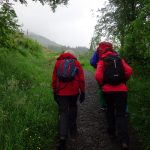 As we set out on a new journey, we might walk with old friends, family or with strangers.
As we set out on a new journey, we might walk with old friends, family or with strangers.
While we might still be full of energy, what lies ahead of us is unknown.
Setting off into the uncertainty has risks – but it also has potential. Refugees risk much when leaving home behind. But the reason they do is for the potential of SAFETY and SANCTUARY. As you climb through the woods and onto the moor, you will pass small streams.
You are invited to pick up a river-stone or small rock from the side of the path and carry it with you: a symbol to remind you of the things we carry when we travel which stay with us. These might be hopes, friendships, love or music – they might also be fears, doubts and regrets. Keep the stone in your pocket as you climb the mountain.
Memory (stage 2)
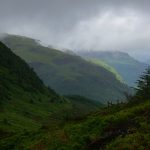 After we have been walking for about 1½ km we leave the woods behind and head out onto the moor, continuing to climb steeply. To our right we see the crags of Creag Ghorn – the ‘Rock of Embers’. Legend says that in ancient times people would celebrate the Beltane spring festival here with bonfires and feasting. As you climb, if you have breath, why not share with a fellow pilgrim something of your religion, faith or belief and how festivals and celebration play a part.
After we have been walking for about 1½ km we leave the woods behind and head out onto the moor, continuing to climb steeply. To our right we see the crags of Creag Ghorn – the ‘Rock of Embers’. Legend says that in ancient times people would celebrate the Beltane spring festival here with bonfires and feasting. As you climb, if you have breath, why not share with a fellow pilgrim something of your religion, faith or belief and how festivals and celebration play a part.
Rescue (stage 4)
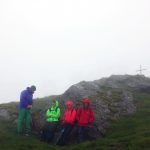 As we approach the summit, we find an unlikely place for a religious symbol.
As we approach the summit, we find an unlikely place for a religious symbol.
In fact this cross is a memorial to Sgt Harry Lawrie, who died in 1987 whilst on a rescue mission with Killin Mountain Rescue Team on Ben More near Crianlarich. Think for a moment about the sacrifice of those that seek to offer ASSISTANCE and PROTECTION to those who are in danger. Why do people put themselves in harm’s way to help strangers?
Why do people give money to charities that help people that they will never meet? All religions have a form of teaching known as the Golden Rule – treat others the way you yourself would want to be treated. It’s why people today are rescuing lives, on mountainsides or in the sea – and why we are walking to show solidarity for those that want to help. And for many people, religion and faith is what guides and sustains them through difficult times.
Hill of God (stage 4)
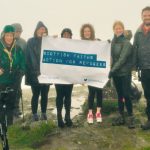 Ben Ledi – the name was once thought to mean ‘Hill of God’, though an error in translation from
Ben Ledi – the name was once thought to mean ‘Hill of God’, though an error in translation from
Gaelic suggests the true meaning could be ‘Hill of the Slope’.
Here at the summit you are invited to think about INTEGRATION and BELONGING: when someone moves to a new culture, what do they need to feel safe, secure and able to contribute to the common good? What does the local community need to do to change to make new arrivals feel welcome? Getting mixed up with language and translations is a common experience for refugees arriving in Scotland who don’t speak English. Many faith groups offer language classes and support to help. Being able to communicate allows us to share culture and through this, gift one another intangible riches about the fullness of life. As a symbol of gifting, leave here the stone you picked up earlier and add it to the cairn on top of the hill – so that future pilgrims can know the way.
Blindness or Vision (stage 5)
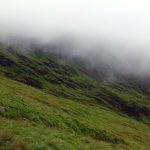 Continuing northwards along the ridge we might pause to take in the view.
Continuing northwards along the ridge we might pause to take in the view.
Or if it is misty, wet and windy then it might be better if we hurry on to somewhere more sheltered. Whether today we can see far or not at all, part of the achievement of mountain climbing is reaching the top. For pilgrims, however, it is not only the destination that is important. The way itself has purpose and meaning. For some the concept of a pilgrimage is a metaphor for life itself.
At some points we can see ahead, be inspired by the view and be clear in our vision for the purpose of our lives. At some points we are just lost in the clouds.
In Judaism, the three festivals of Pesach (Passover), Shauvot and Sukkot are known as Pilgrimage festivals when the ancient Israelites would travel to Jerusalem. In Islam, there is a requirement known as Hajj that every Muslim should travel to the holy city of Mecca. For Christians visits to holy shrines, wells and other places have also been an essential part of spirituality – and one which is finding new popularity in Scotland today.
Remember (stage 5)
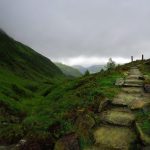 Following the line of metal fence posts down the ridge we eventually reach the Bealach nan Corp – the Pass of the Dead. At the pass we turn right and start descending into Stank Glen. In ancient times this would be a funeral route for people living in Glen Finglas to the west taking bodies for burial at St Bride’s Chapel on the other side of Loch Lubnaig to the east. As we head down the hillside, remember those who have died. This might be friends or family members that we have known, but also remember those who have died on the journey to seek refuge. The International Organisation for Migration’s Missing Migrants project has recorded more than 13,800 deaths in the Mediterranean since the start of 2014. Remember them, for they had no-one to carry them to a burial place.
Following the line of metal fence posts down the ridge we eventually reach the Bealach nan Corp – the Pass of the Dead. At the pass we turn right and start descending into Stank Glen. In ancient times this would be a funeral route for people living in Glen Finglas to the west taking bodies for burial at St Bride’s Chapel on the other side of Loch Lubnaig to the east. As we head down the hillside, remember those who have died. This might be friends or family members that we have known, but also remember those who have died on the journey to seek refuge. The International Organisation for Migration’s Missing Migrants project has recorded more than 13,800 deaths in the Mediterranean since the start of 2014. Remember them, for they had no-one to carry them to a burial place.
Peace (stage 7)
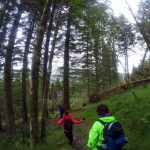 The final leg takes us through the tranquillity of this forest. Our path leads us by babbling brooks and gentle waterfalls. The quiet and peace of the valley is a contrast to the exposed and desolate hill tops. The walk is nearly over, and no doubt you are beginning to hope for some peace and rest for your feet and legs. But if you have access to an Ordnance Survey map you will see on the opposite side of the water ahead of us the path of an Old Military Road. A reminder that, however remote and peaceful this place feels today, and so far removed from the trouble-spots of the world, it was not always so. A powerful government worried about violent rebellion used military force – which has left its mark on the landscape which can still be seen today. As we get to the journey’s end, remember that Peace is never to be taken For granted, and that we all need to continue to work for it, all the days of our lives.
The final leg takes us through the tranquillity of this forest. Our path leads us by babbling brooks and gentle waterfalls. The quiet and peace of the valley is a contrast to the exposed and desolate hill tops. The walk is nearly over, and no doubt you are beginning to hope for some peace and rest for your feet and legs. But if you have access to an Ordnance Survey map you will see on the opposite side of the water ahead of us the path of an Old Military Road. A reminder that, however remote and peaceful this place feels today, and so far removed from the trouble-spots of the world, it was not always so. A powerful government worried about violent rebellion used military force – which has left its mark on the landscape which can still be seen today. As we get to the journey’s end, remember that Peace is never to be taken For granted, and that we all need to continue to work for it, all the days of our lives.
With thanks to the Rev David J. M. Coleman for permission to use his photographs.
